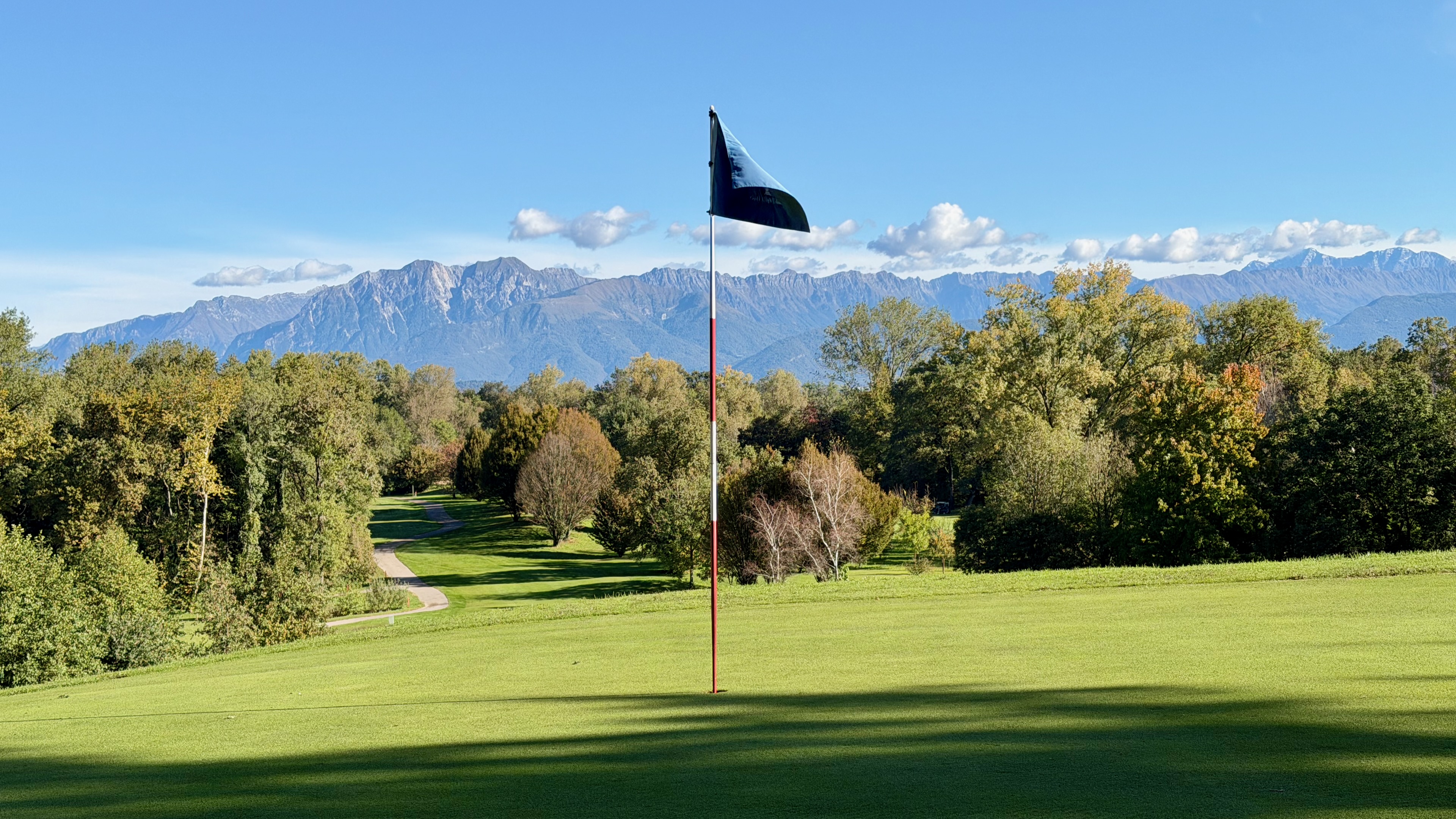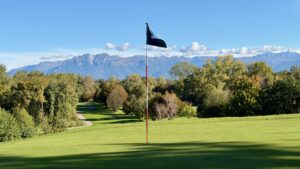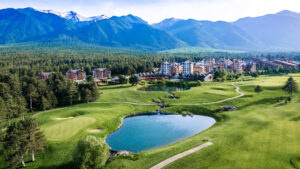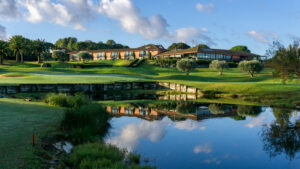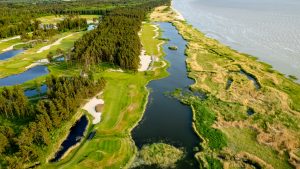You’ve heard of— and probably been to— Venice. But did you know that right next door is one of Italy’s most exciting gastronomic regions? We went to Friuli Venezia Giulia to try it out, and to find time to play some golf in between meals.
Where is Friuli Venezia Giulia, you might ask? One good way to describe it is as the north of southern Europe, the south of northern Europe, the west of eastern Europe, and the east of Western Europe, in other words, a real cultural crossroads. It borders Austria in the north, Slovenia in the east, the Adriatic Sea in the south, and Veneto in the west. It has a unique diversity with mountains (the Dolomites, Carnic Alps, and Julian Alps), plains, and a 130 km coastline with plenty of sandy beaches, all within two hours’ drive.
With such a central location, the area has belonged to a number of countries and empires over the centuries (too many to mention in this article) and only formally joined Italy as late as 1975.
Friuli Venezia is most famous for its food and wine, a gastronomic heaven, if you will. It is one of Italy’s leading white wine regions, unusual since Italy is mostly about red wine. Famous local grape varieties include Friulano (formerly Tokai), Ribolla Gialla, Refosco dal Peduncolo Rosso, Terrano, Malvasia, Pinot Grigio, and Sauvignon Blanc. It has rich local culinary traditions offering a fusion of Italian, Austrian, and Slovenian flavors and many small family-run producers (over 400), producing wine, cheese, beer, and ham, for instance the renowned San Daniele ham (prosciutto di San Daniele), one of Italy’s finest hams. You can enjoy all of this by following a wine and food route, such as “Strada del Vino e dei Sapori” (Wine and Taste Route), that allows visitors to create custom itineraries to visit a sampling of the over 400 farms, vineyards, and artisans.
We came here early in October to play some golf, so we followed a different route. But it soon became apparent that even the golf route was a gourmand’s delight, and with a maritime twist at the end.
Nine courses to choose from
Friuli Venezia has nine different 18-hole golf courses to choose from across the region, offering different experiences and landscapes, with some in the foothills of the mountains, some on the plains, and some right on the coast.
Golf Club Udine
Our first stop after a quick transfer from Venice Marco Polo airport was Golf Club Udine. The club is located right next to the very unique Villaverde Hotel and Resort, our hotel for the night.
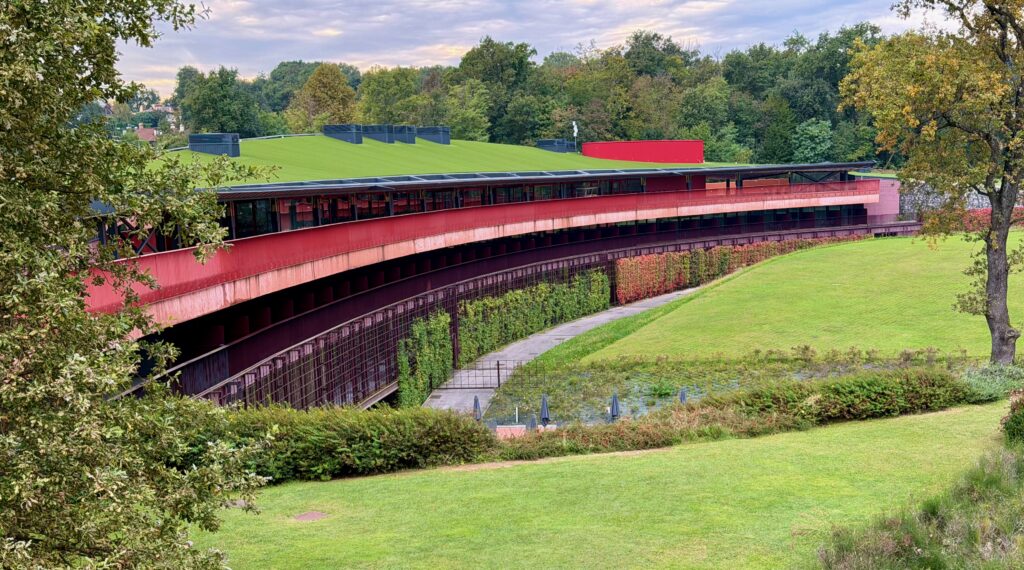
The hotel has a unique architecture bringing together regional heritage and contemporary luxury, created by famed local minimalist architect Alessio Princic with influences from Frank Lloyd Wright and Alvar Aalto. It is shaped as a crescent and well hidden in a hillside, with all the rooms facing in the same direction with a view of the golf course and the mountains. It is also inverted; the reception is on the top floor, and all the rooms are one floor down, with all rooms on a single floor. One floor further down is the very well-equipped gym and a beautiful, medical spa.
We started our visit with what else— food. Villaverde served up a magnificent multi-course dinner in what felt like a very private dining area even though it was part of the main restaurant. The dinner far exceeded expectations, with courses like:
- Prosciutto di San Daniele with a glass of Prosecco Isola Augusta
- Pasta with Sauris speck and a Friulian Cabernet reduction served with a Cabernet Sauvignon Isola Augusta
- Braised pork cheek with creamy polenta and oven-roasted potatoes
- Homemade tiramisù — rich mascarpone cream layered with espresso-soaked savoiardi paired with a glass of Ratafiocco Còs
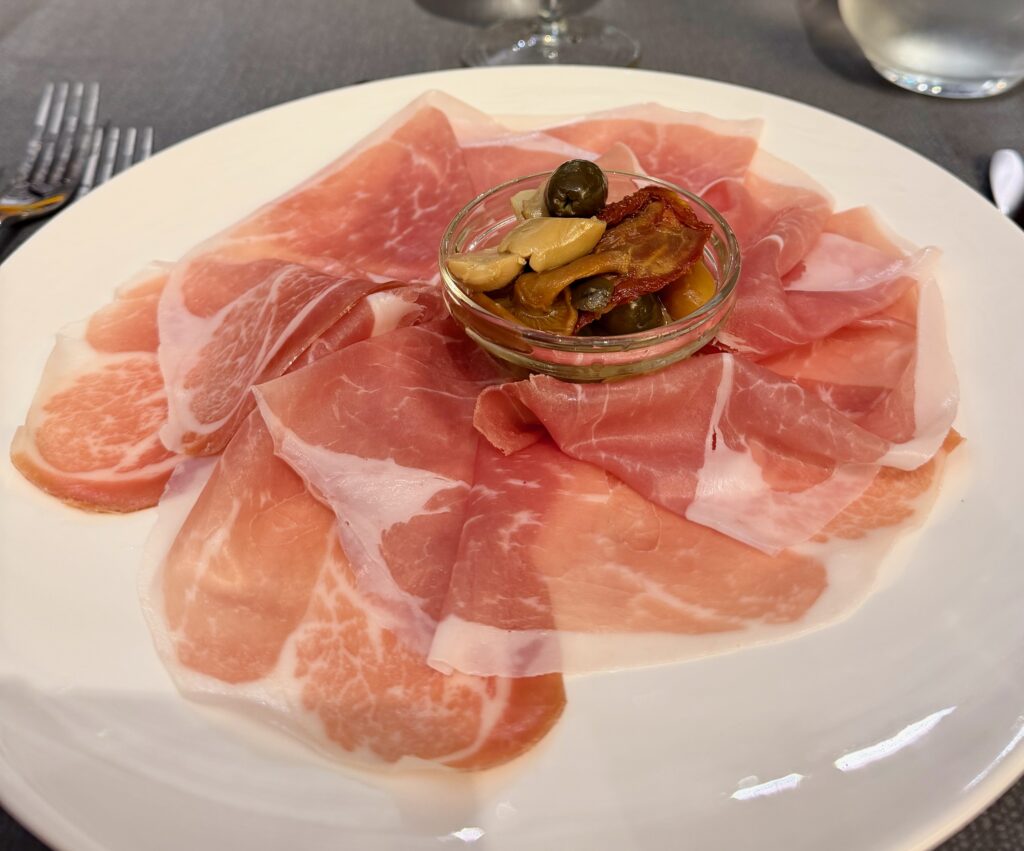


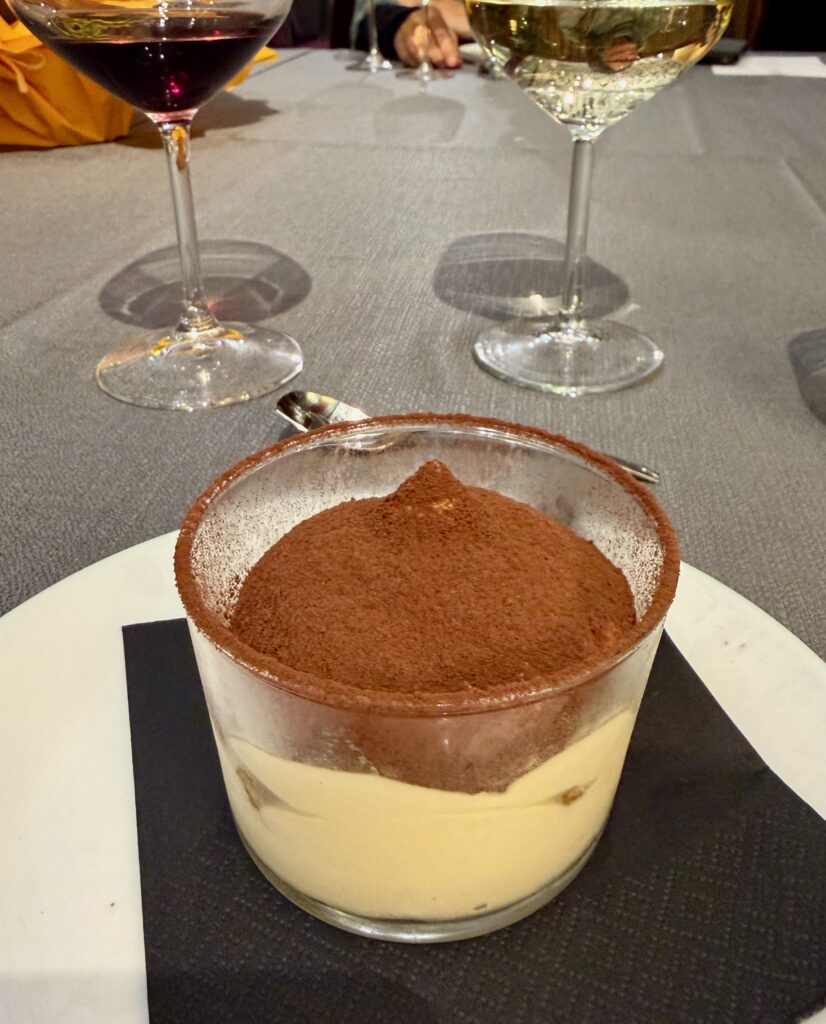
You get the idea. We were not going to go hungry on this trip.
The next morning, it was time for golf. After warming up on the elevated driving range, we set out to tee off on the 18-hole championship course at Golf Club Udine.
The course is a parkland course, but with plenty of old and well-established birch and oak trees, over 7000. If you are lucky, you can spot both stork and ibis up in the trees. It was designed by John Harris as a 9-hole course in the 70s and later expanded to 18 holes by Marco Croze. Playing at 6290 meters and par 72, the course is of championship quality and hosts international events annually such as the Senior European Tour.
The first hole sets the tone with a generous downhill fairway, although you quickly understand that you will need to stay clear of the trees lining the fairway. A good opening hole to build your confidence.
The first nine continues with tree-lined holes. When you reach the 6th, “The uphill monster,” you get your first real challenge. A dogleg par 4 with a tee shot that is slightly downhill, you then face an approach shot to a green high above. Once you claw your way up, you are rewarded by maybe the best view of the day from behind the green; a clear view of the Julian Mountains.
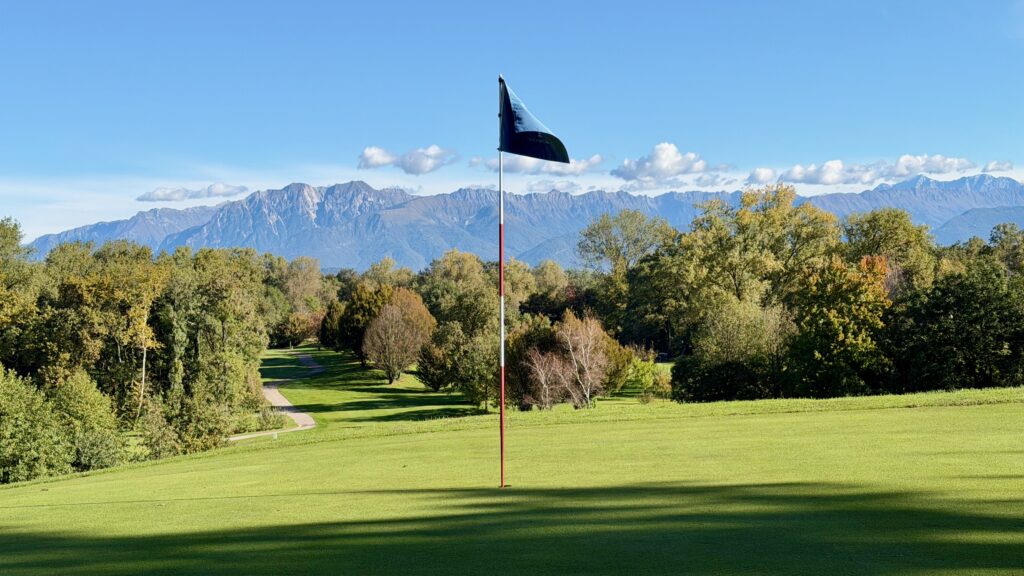
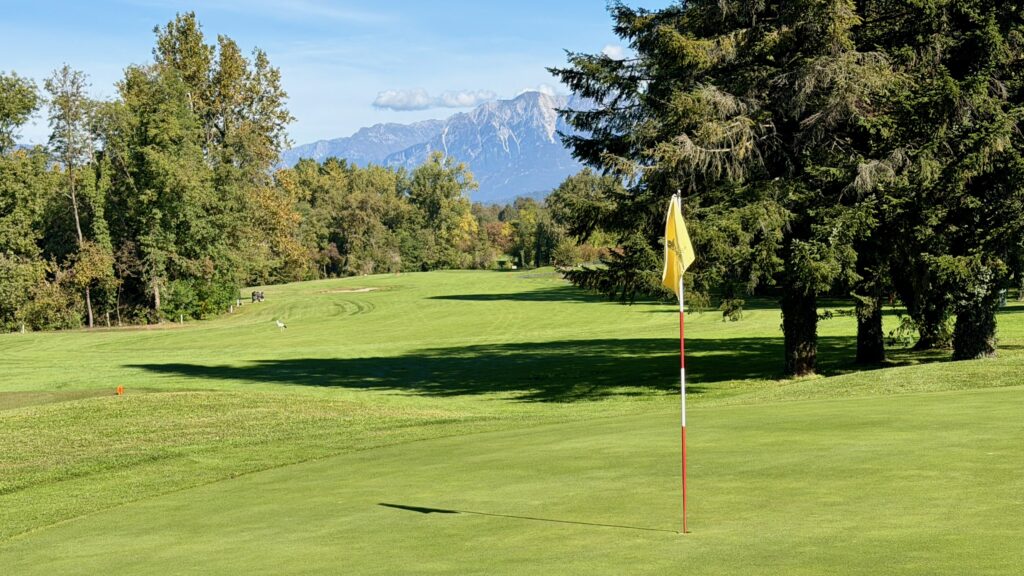
Hole nine, an uphill par-4, takes you back to the clubhouse and a chance to get some refreshments.
The back nine is even more challenging than the front, with the addition of water to take into account. On the thirteenth, you have to be very accurate with your tee shot, with two lakes on the right side and dense forest on the left, a very challenging but beautiful hole.
The signature hole is the fifteenth, a long par four with a dramatic downhill tee shot. If you are aggressive, you have a fair chance at an eagle, but also a fair chance at hitting the lake that is guarding the green.
The course finishes with a couple of nice par 4s, with quite a long walk from 17 to 18.

We found the course in good shape, just a little bit wet in spots after the rain the day before. The course is walkable, but quite hilly in spots, so a buggy is recommended for most players. All in all, a pleasant experience, and we would love to come back and play the course again, now that we have seen all the hidden dangers. Highly recommended.
Aquileia
After an excellent lunch at the clubhouse, we headed towards our next stop in Trieste, but on our way, we stopped in Aquileia to tour the Basilica di Santa Maria Assunta. The basilica is one of the very first Christian churches, with construction started only a few years after Christianity was officially allowed in the Roman Empire around 313 AD. The basilica you see today was constructed much later in 1031 AD, but retains significant elements and layers from its fourth-century origins, most notably the mosaics.
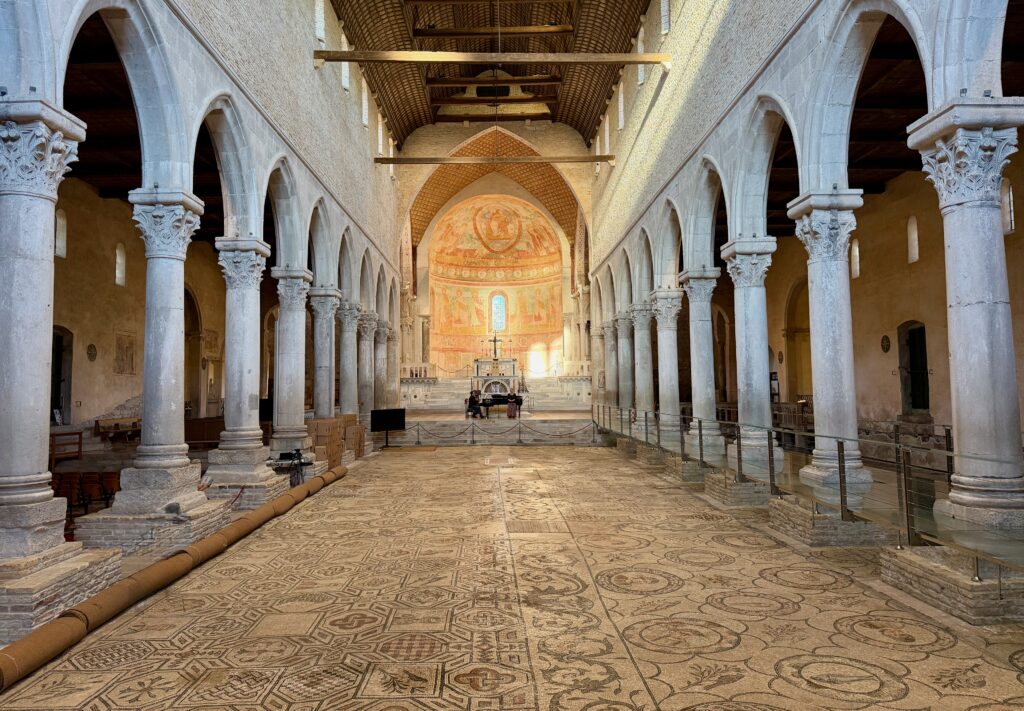
The mosaics in Aquileia’s Basilica di Santa Maria Assunta are among the most impressive and significant early Christian artworks in Europe. The mosaic floor had been almost forgotten, preserved under centuries of renovations, new flooring, and debris. Between the late 1800s and early 1900s, restoration and archaeological campaigns began removing later medieval floors in the basilica. This revealed the vast early Christian mosaic carpet, dating from the early 4th century, lying about a meter below the main sanctuary floor. Throughout the 20th century, particularly in the crypts and the area under the bell tower, further digging revealed layers of earlier buildings, religious structures, Roman houses, and additional mosaic art. All of this is now open to the public. Don’t miss touring the basilica if you are in the area.
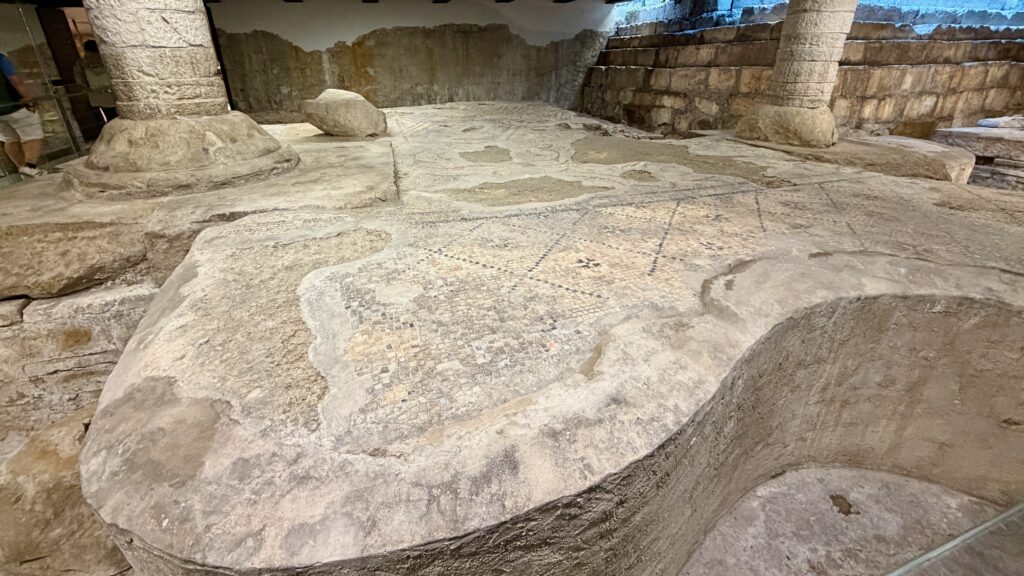

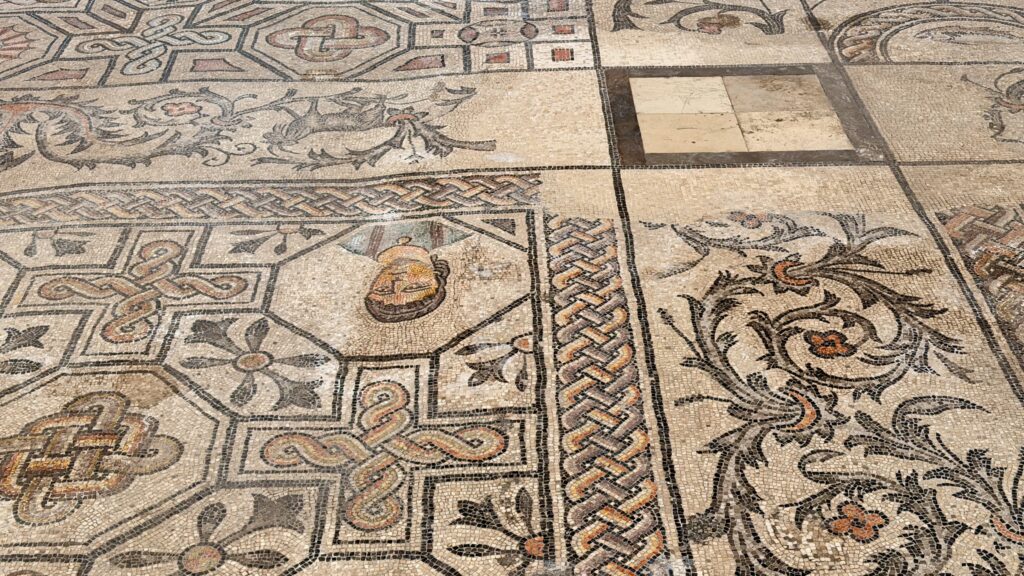
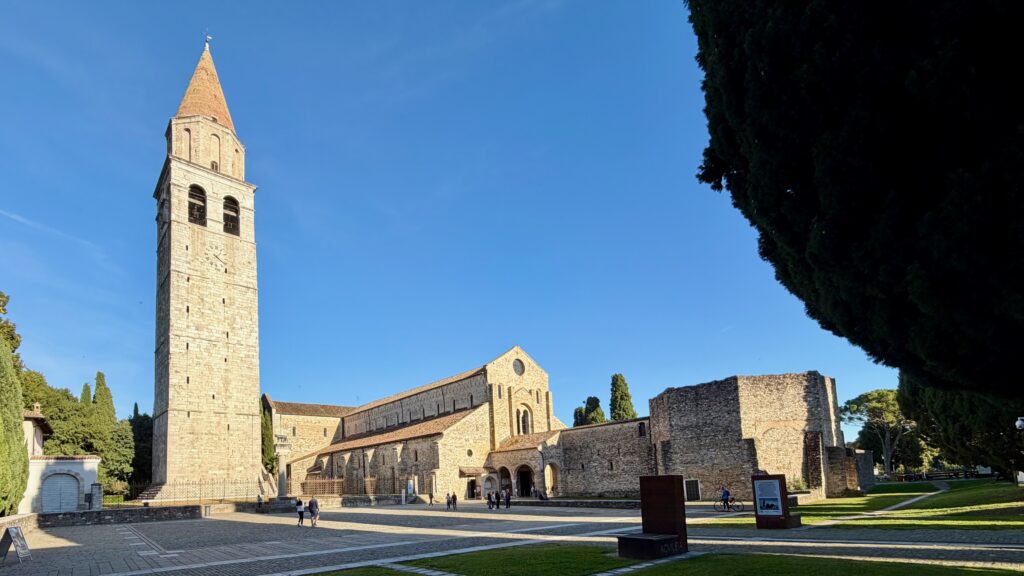
Golf Club Trieste
The next morning we set out for a morning round at the classic Golf Club Trieste. The club holds a special place as the very first golf club established in Friuli Venezia Giulia. Founded by British and American Allied military members right after World War II, the club formally opened in 1954 as a 9-hole course, later expanded to a full 18. Set at an altitude of roughly 350 meters on the rugged Carso plateau, the course is just a few kilometers outside Trieste and a stone’s throw from the Slovenian border. Here, Mediterranean oaks and pines frame sweeping fairways, and the climate, tempered by the famous Bora wind, allows for year-round play.
As you pull into the parking lot and wander the grounds, you’re reminded this is not just a sporting venue but a lively part of regional heritage, an institution that has evolved for over seven decades while maintaining a warm community feel. You really feel the winds of history.
The course is a mix of parkland and forest. Most of the holes are pretty straightforward but not necessarily easy, especially on days when the famous Bora wind is strong. You can feel the difference between the original nine holes and the “new” additions. We definitely preferred the original holes.
The most notable hole comes towards the end of the round. The signature 17th hole is a real showstopper, with a blind, uphill tee shot. It looks quite ordinary at first, but once you reach your ball (hopefully) at the top of the hill, you are treated to a stunning view of Trieste, the bay, and a view all the way to Slovenia and Croatia. Once you have gotten your fill of the panorama, you have to regain your focus because the green below hangs on the edge of a drop-off. Precision is required to successfully navigate this stunner of a golf hole.
Back at the clubhouse, we settled in the “Buca 19” restaurant and bar. From the outside terrace, you can enjoy the view of the bay as we did. Had we visited in the winter, we could have enjoyed the inside restaurant, built in a classic British-Italian style complete with a fireplace to warm you up after your round.
The restaurant serves high-quality Mediterranean and local cuisine, with a focus on fresh, seasonal ingredients, and we were once again treated to a lunch that didn’t disappoint.
As we headed back to Trieste, the golf part of the trip was now over. But more excitement was on deck. Literally.
Trieste
As we arrived in Trieste, it immediately became obvious that this was no ordinary afternoon. The city was jam-packed with people, all in a celebratory mood. Why? The Barcolana sail race was taking place tomorrow, Sunday. But more on that later.
In spite of the crowds, we managed to tour the city on foot. The city has a rich and eventful history; originally a Roman city called Tergeste, it grew into a vital port in the vast Habsburg Empire from the 18th century right up to World War I. Later, it bounced between Austria, Italy, and even held “Free Territory” status after WWII before finally settling into modern Italy. Walking its streets, you can feel those layers, the stately neoclassical facades from the Austrian period sitting right next to lively Italian markets and elegant Viennese cafés.
We began at Chiesa di Sant’Antonio and followed the canal to the sea, joining the steady stream of people drawn outdoors by the building excitement. Flags flapped along the quays, and the chatter everywhere buzzed with talk of the next day’s Barcolana 57.
As we reached the waterfront, the Grand Canal was crowded with sailors and visitors all mingling as boats made their final pre-race checks, and crews in branded jackets hurried between harborside stalls. The quay was lined with pop-up tents, sponsor banners, and the scent of street food. As the sun started to set, the gulf was scattered with yachts, some practicing starts, others simply showing off their colors.
Walking down the quay toward Piazza Unità, you could feel the city vibrating in anticipation. The square itself was animated by performers, sound checks, and people finding the best vantage for the entertainment. It was Trieste in full festival mode, proud of its maritime roots and bound together by the allure of the sea and the world’s biggest regatta.
We were lucky to be invited to one of the racing boats, the Freetime, a 64-foot Solaris yacht, where we enjoyed some prosecco and snacks. It was quite interesting to explore the boat and see all the preparations for tomorrow’s race.
After all the mingling, we proceeded to one of the finer establishments in Trieste, the Chimera di Bacco, for yet another culinary treat: a seven-course tasting menu. Needless to say, the dinner was perfect, with each course matched with local wines. I’m not a food writer, but I’ll leave you with photos of a few of the dishes. Another restaurant not to miss.
Barcolana Day
We woke up to a perfect day for sailing: full sun and a light breeze, enough to make for an exciting race but not strong enough to make us seasick. Seasick? Yes, we were going to be in the middle of the race, not as participants but as observers on a RIB boat.
The Barcolana is an annual international sailing regatta that has taken place in Trieste since 1969, rapidly evolving from a local race of just 51 boats to a record-breaking event recognized as the world’s largest sailing race. Held every October, the regatta draws professionals, amateurs, and cruising families alike, sailing in boats of all shapes and sizes. In this year’s Barcolana 1,865 boats with over 15,000 sailors took to the starting line, including supermaxis, traditional monohulls, family cruisers, and classic yachts, creating a spectacular mix of vessels and skill levels, all racing together.
Having a RIB boat powered by 800 hp outboard engines turned out to be the perfect way to see the race, front and center. It allowed us to get up close, but still have enough power to quickly get out of the way of the yachts when necessary.
In the end, Arca Sgr of Fast and Furio Sailing Team won the 57th edition of Barcolana, crossing the finish line first on an upwind leg at 12 knots of speed, with a race time of 1 hour, 43 minutes, and 42 seconds in light wind conditions. This was no surprise, as this was the 7th win in the last 10 years for Furio Benussi and his Don Jones turbo maxi 100-foot yacht. But we were also winners, having had the chance to follow this exciting race up close.
Portopiccolo
After the being at sea and taking part of the celebrations we were quite wasted and retreated to our hotel Tivoli in Portopiccolo near Trieste. The hotel is located centrally in a master-planned coastal “borgo” (village) located in the Duino Cliffs Nature Reserve. The project includes residences, luxury hotels, a full-service marina, restaurants, shops, conference spaces, and car-free paths climbing up the terraced limestone cliffs. The project is quite new, opening just a few years ago, and it will be interesting to see if it lives up to its ambitious goals of blending Mediterranean lifestyle and sustainability with modern architecture.
Hotel Tivoli certainly left nothing to be desired with beautifully appointed rooms, extensive spa and wellness facilities including treatment rooms, a large vitality pool, saunas, a modern gym, fitness and wellness center, multiple restaurants and bars including Purobeach Portopiccolo, a beach club, and gourmet dining with Mediterranean cuisine. We were pampered.
The next morning I woke up to a beautiful sunrise. I took a walk down to the beach in Portopiccolo and reflected on my days in Friuli Venezia Guila. It was a short trip, but with so many wonderful experiences. I can’t wait to have a chance to visit again, and I hope you have an opportunity to go, too.
